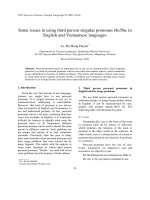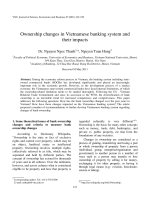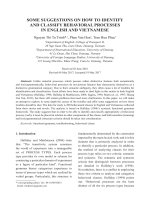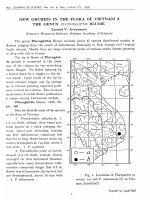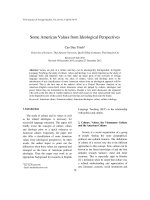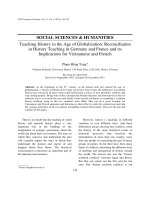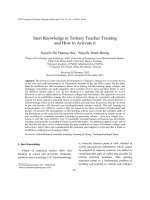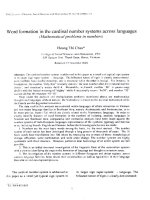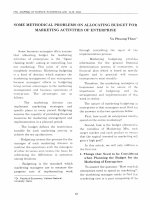DSpace at VNU: Some issues in using third person singular pronouns He She in English and Vietnamese languages
Bạn đang xem bản rút gọn của tài liệu. Xem và tải ngay bản đầy đủ của tài liệu tại đây (150.84 KB, 7 trang )
VNU Journal of Science, Foreign Languages 27 (2011) 30-36
Some issues in using third person singular pronouns He/She in
English and Vietnamese languages
Le Thi Hong Duyen*
Department of Foreign Languages, Haiphong Medical University,
No.72A Nguyen Binh Khiem Street, Ngo Quyen District, Haiphong, Vietnam
Received 28 February 2010
Abstract. Personal pronouns play an important role in any act of communication. Each language
possesses a system of personal pronouns with its own rules and cultural aspects, which sometimes
causes difficulties for learners of different cultures. This article will attempt to look at some issues
in using third person singular pronouns He/She in English and Vietnamese through some certain
situations so as to help learners and translators understand and use them correctly.
1. Introduction*
2. Third person personal pronouns in
English and its usage problems
From the very first lessons of any language,
learners are taught how to use personal
pronouns. It is simply because in any act of
communication, addressing is unavoidable.
However, that kind of pronoun is not always
clear for learners of English and Vietnamese to
use and understand properly. In fact, personal
pronouns can be a lot more confusing than they
seem. For example, in English, it is sometimes
difficult for learners to identify what noun the
pronoun refers to. In Vietnamese, different
personal pronouns can be used to denote the same
person in different contexts. Such problems are
not unique and anyone of us may sometimes
encounter. Previously, time has seen so many
ideas and researches about personal pronouns and
their usage problems that were carried out by
many linguists. This article with the analysis at
some usual situations in which third person
personal pronouns “He/She” are used will reveal
some problems faced by learners of both cultures.
We use third person personal pronouns to
substitute people or things being spoken about.
In English, it can be characterized by case,
gender, and number (Quirk,1987) [1]. The
following table will illustrate the point:
2.1. Case
Grammatically, case is the form of the noun
or pronoun built up by means of inflexion,
which indicates the relations of the noun or
pronoun to the other words in the sentence. In
other words, case is a characteristic of a noun or
pronoun determined by the function it performs
in a sentence.
Personal pronouns have two sets of caseforms: nominative (or subjective) case and
accusative (or objective) case.
For the third person (as mentioned on Table 1):
He, she, it, they are used as nominative case.
______
*
Tel.: 84-912489409.
E-mail:
30
L.T.H. Duyen / VNU Journal of Science, Foreign Languages 27 (2011) 30-36
31
Table 1. Third person personal pronouns in English (Source: www.WeblearnEng.com)(1)
Number
Gender
Singular
Masculine
Feminine
Neuter
For both sexes
Plural
Case
p:
Nominative/ Subjective
He
She
It
They
Accusative/ Objective
Him
Her
It
Them
.weblearneng.com/the-personal-pronouns
3//www
Him, her, it, them stand for accussative case.
The nominative case is needed when a personal
pronoun is used as subject of finite verb and as a
predicative nominative (subject complement).
Meanwhile, the objective case is used when the
personal pronoun is direct or indirect object of the
verb and object of preposition.(1)
We should be careful not to confuse
personal pronouns in the nominative and
accusative case.
+ subject of finite verb = nominative case
Incorrect: Him and her went to the party.
Correct: He and she went to the party.
+ object of verb= accusative
Incorrect: Tom wants to meet you and they.
Correct: Tom wants to meet you and them.
+ object of preposition= objective case:
Incorrect: Is there any relationship between
you and she?
Correct: Is there any relationship between
you and her?
In standard written English, the personal
pronouns in the predicative nominative are the
same as they would be in the subject. Most
native speakers do not speak in this way, but it
is grammatically correct. This nonimative case
follows a linking verb to rename the subject:
e.g. The winner was her. (socially accepted)
The winner was she. (grammatically accepted)
Sometimes, we also use nominative case for
pronouns that follow forms of the verb be and
describe the same person or thing as the subject.
e.g. It’s her, not him. (socially accepted)
It’s she, not he. (grammatically accepted)
2.2. Gender
The third plural pronoun they/them do not
set apart by gender. However, the third person
singular pronouns distinguish in gender
between masculine (he/him), feminine (she/her)
and neuter (it).
In some special use, he/she refers to the
gender of animals when the animal’s sex is
known and is of interest such as she-bear, shegoat, she-ass...he-cat, he-dog...(2)
e.g. What a little sweet dog! It is a he or a she?
He/she is sometimes used to emphasise
gender of people in some cases:
e.g. He-man: a particulary strong, masterful,
or virile man
She-male: male homosexual or transvestite.
Is the child a he or a she? (unknown gender
of newborn child)
The pronouns he and she in English are not
only used to replace names of people but also
the names of some special places, things or
objects. Normally, he is used to denote strong
objects, terrible ideas, rivers, mountains, etc.
And she represents beautiful and nice concepts,
ships, towns, and cities, countries, etc [2].
e.g. The name Roma is used to refer to the
ancient Roman Empire. She was founded by
Romulus in 753BC on Palatine Hill.
In addition to that, pronoun he is sometimes
used to refer to human being in general.
______
______
(1)
(2)
/>
/>
32
L.T.H. Duyen / VNU Journal of Science, Foreign Languages 27 (2011) 30-36
e.g. He who laughs best, laughs last.
Although the rule of using “he/she” in
English is quite simple and sounds like “no
matter”, it sometimes causes headache to learners.
2.3. Gender- problem
One of the controversial problems while
using personal pronouns is gender which
learners sometimes find it difficult to choose
from for the indefinite antecedent that required
a singular pronoun.
Traditionally, English speakers have used
the pronoun he/him generically in contexts in
which grammatical form of the antecedent
requires a singular pronoun.
e.g. A novelist should write about what he
knows best.
Despite grammatically correct, this type of
construction will face problems of both sexist
and illogical. The novelist, in this case, could be
a man as well as a woman. Some experts would
argue that he in this sentence is used generically
that the pronoun is understood to both he and
she. This analysis of the generic use of he is
linguistically doubtful. If he was truly a genderneutral form, we would expect that it could be
used to refer to the members of any group
containing both men and women; but in fact, the
English masculine form is an odd choice. The
traditional usage like above has gone under
criticism for reflecting gender discrimination
(Nguyen,V.K [2], Tran, X.D.[3]). As more people
become sensitive to sexist language this use is less
convincing.
In this case, many learners sidestep the
problem by using they/them in the place of
he/him like:
e.g. If anyone calls, tell them my message.
Other people choose the way of replacing
he or she, him or her instead.
e.g. A novelist should write about what he
or she knows best.
The first solution may ignore grammatical
standard that anyone should be treated as a
singular form. And in this situation, learners
break the rule of pronoun-antecedent agreement
by using the plural pronoun they. Although this
method is gaining popularity, it is still not
acceptable for most formal writing.
The latter using both pronouns can create an
unwieldy or cumbersome sentence, especially in
the texts with much of the same indefinite
pronouns and nouns. Moreover, this solution can
be criticized for still putting the male form first
although the alternative “she or he” is not better.
Some people raise the solution of creating a
new word for neutral gender like “hey” which
is derived from they or s/he to refer to both he
and she. This solution, however, is far from
social recognition.
Better methods of eliminating an
inappropriate gender-specific pronoun may
include:
+ Rephrasing the sentence to eject the
problem
e.g. Instead of saying “If anyone calls tonight,
give him my message”, we rephrase: “Please tell
my message to anyone who calls tonight”.
+ Using a plural noun and pronoun
e.g. Novelists should write about what they
know best.
+ Substituting the gender- specific pronoun
with gender neutral noun.
e.g. If anyone calls tonight, give the caller
my message.
2.4. Unclear pronouns
Apart from the problem of gender in using
pronouns, there is another problem faced by
learners of English. The problem is how to
identify exactly what noun the pronoun refers
to. Usually, a pronoun refers to the word that
immediately precedes it. However, this is not
always clear, especially if the pronoun comes a
bit after the noun to which it refers.
e.g. Linh told her mother that Mai invited
her to the party.
L.T.H. Duyen / VNU Journal of Science, Foreign Languages 27 (2011) 30-36
In this example, pronoun her stands for
whom - Linh or her mother?
The puzzle while using pronoun never ends
with only the third person singular pronoun
mentioned above. In fact, even native speakers could
be embarrassed with personal pronoun usage.
Professor Karen Weekes from Georgia
University once raised his problems online:
“I’m teaching a multi-cultural Women’s
Studies class this semester, and my class of 100
is very diverse. Last week, I was talking about
the concept of white privilege, and I found
myself tangled in pronouns. Do I say it’s
something “we” experience, since I’m white? If
I do, I feel like my inclusive “we” means I’m
talking only to a certain portion of the
classroom, but if I say “they” then I felt like I’m
setting myself off outside my race, as if to say
that “they” all have a problem but “I” have
enlightened myself beyond that. This may
sound ridiculous, but I caught a funny look on a
couple
of
black
students...”
(From
Subject
,
Pronoun?, Fri, 17 Sep, 1999).
So far, the use of personal pronouns are not
simple as what they seem. This also reveals that
English is a kind of generalized language system.
3. Vietnamese third person singular
pronouns and some principles in use
It is said that Vietnamese grammar is one of
the most complicated systems among languages
in the world. Understanding and using it
appropriately is not so easy, even for
Vietnamese people.
33
In Vietnamese, pronouns play an important
role [4,5], of which personal pronouns rank at
special position. Because of their complexity,
Vietnamese personal pronouns are not
considered according to case, number, gender
as they are in English but the contexts and
outside factors. This is the main difference of
personal pronouns of the two languages. In
English, the pronouns only change their forms
due to their functions in the sentence, for
example, “he” of nominative case turns into
“him” when it takes a place of an object.
Vietnamese ones, in contrast, stay the same in
the sentence no matter of their grammatical
function, but change forms in different
situations.
When talking about third people or things,
Vietnamese people do not use stable pronouns
but flexible ones. That is to say, Vietnamese
third person personal pronouns vary depending
on age, sex, social postion, level of intimacy,
etc. This complexity leads to some usage
problems for learners of Vietnamese.
In this article, I only mention some popular
principles in using third person singular
pronouns to denote “he/she” in Vietnamese.
First, they can be classified by formal and
informal contexts as follows:
However, the clasification above cannot
display the correlation of pronouns with other
objective factors. Thus, another way to classify
Vietnamese third person personal pronouns is
due to following factors:
- Age of third persons in comparision with
the speaker
- Attitude of the speaker
- Dialect
Table2. Vietnamese third person personal pronouns
Formal
Informal
He
ông ấy/anh ấy...
ông ta/ anh ta/hắn/ y...
She
bà ấy/ cô ấy/chị ấy...
bà ta/ cô ta/chị ta/ ả/ thị
Table2: Vietnamese third person personal pronouns
3.1. Influence of age
In Vietnamese, there is a clear age-ranking
system that distinguishes children, teenagers,
adolescents, middle-aged people, old people in
addressing. Therefore, age factor is very
important in Vietnamese personal pronoun
34
L.T.H. Duyen / VNU Journal of Science, Foreign Languages 27 (2011) 30-36
usage. It helps the speakers in conversations
find appropriate pronouns to refer to the people
they are talking to.
+ If the person is much older than the
speaker (approximately at the same age of the
speaker’s parents or grandparents, etc.) the
pronouns should be used as:
He/him: ông ấy, ông ta
She/her: bà ấy, bà ta
e.g. Ông Năm có tất cả năm người con. Ông
ấy đã nghỉ hưu.
(Mr. Nam has five children. He’s retired.)
It is noted that the pronoun with the tail
“ấy” is used at a bit higher level of intimacy
than the one with “ta”.
Sometimes nouns like “ông”, “lão” (for male)
and “bà”, “mụ” (for female) are used as personal
pronouns that refer to the antecedent nouns.
e.g. - Ông Tám đã ngoài bảy mươi nhưng
ông vẫn tập thể dục đều đặn.
(Although Mr. Tam is over seventy, he still
does morning exercises regularly).
- Bà Lơ-Brăng bày tỏ niềm vui được thăm
lại Việt Nam. Bà khẳng định Chính phủ Pháp
luôn coi trọng quan hệ hữu nghị với Việt Nam.
(Ms. Le Brance shows her delight for
coming back to Vietnam. She confirmed the
special concern to the friendship between
France and Vietnam.)
+ If the person is a bit older than the
speaker (approximately at the same age of the
speaker’s sister, brother, or aunt, or even the
speakers themselves), the pronouns are:
He/him: anh ấy, anh ta
She/her: chị ấy, chị ta, cô ấy, cô ta
e.g. Tôi học cùng với Linh từ nhỏ nên tôi rất
hiểu cô ấy.
(I have studied with Linh since we were
children so I know her very well.)
Also, sometimes the nouns “anh” (for
male) and “chị”/“cô” (for female) are used
temporarily as pronouns.
e.g. Anh Nam đưa mắt nhìn Đào, chị cũng
nhìn anh cười tủm tỉm.
(Nam takes a glance at Dao, she looks at
him and smiles.)
+ If the third person is younger than the
speaker, people use “nó” for both singular male
and female.
e.g. - Lan là ai vậy? Nó là con cô Mỹ.
(Who is Lan? She is My’s daughter.)
- Thằng bé này thông minh quá. Nó học lớp
mấy rồi?
(This little boy is very intelligent. Which
grade is he in?)
3.2. Influence of the speaker’s attitude
In English, people use “he/she” when
talking about singular third person with
ignorance of the speaker’s attitude. But it is
quite different in Vietnamese. This factor is
very complicated due to the complexity of the
speaker’s attitude to the person spoken about.
Nguyen, Q. [4] illustrates the use of he/she
in Vietnamese in terms of the speaker’s attitude
as follows:
Positive
Neutral
Negative
HE
Anh/Ông/
Cụ/
Chàng/
Ngài/
Người/...
Anh ấy/ Cậu
ấy/ Ông ấy/
Anh ta/ Cậu
ta/ Ông ta/...
SHE
Chị/ Cô/
Bà....
Nàng/
Người....
Chị ấy/ Cô ấy/
Bà ấy/ Chị ta/
Cô ta/ Bà ta...
Gã/ Hắn/ Y/
Lão/ Thằng
cha ấy/
Thằng khỉ
ấy/ Thằng
chó ấy...
Mụ/ Ả/ Thị/
Con mụ ấy/
Cái mụ ấy...
From the table above, we can see the
speaker’s attitude is considered in three main
aspects: postive, neutral and negative. However,
in fact, we still see a little difference among the
choice of personal pronouns within each aspect.
Therefore, in my point of view, the factor of the
speaker’s attitude should be illustrated clearer
as follows:
L.T.H. Duyen / VNU Journal of Science, Foreign Languages 27 (2011) 30-36
HE
SHE
Positive
Neutral
Negative
Người>
Ngài>
Cụ>
ÔngAnh...
Người>
Bà-ChịCô ...
Ông ấy-Anh
ấy-Cậu ấy>
ông ta-anh
ta-cậu ta...
Thằng cha
ấy-Thằng
khỉ ấy> Y >
Gã> Lão>
Hắn...
Con mụ
ấy> Cái mụ
ấy>Mụ>
Ả> Thị....
Bà ấy- Cô
ấy-Chị ấy >
Bà ta-Cô taChị ta.....
Note: “>” means “more”
With this classification, we can see different
levels of feeling and attitude of the speaker to
the third person.. This is also a typical
characteristic of Vietnamese personal pronouns,
which is hard to be found in any other
languages. Compare the following examples:
(a) Chị lặng yên không nói, chỉ chăm chăm
nhìn lũ trẻ.
(b) Chị ấy lặng yên không nói, chỉ chăm
chăm nhìn lũ trẻ.
(c) Chị ta lặng yên không nói, chỉ chăm
chăm nhìn lũ trẻ.
Obviously, the speaker’s attitude in the
three sentences are at three levels of intimacy
and sympathy.
One more interesting thing is that the
variety of word choice enables us to interpret
the speaker’s attitude to the third person in
Vietnamese within only one sentence unit,
while in order to do so in English, we need to
take the whole situation (a paragraph, a chapter
or even a story) into consideration.
For example, in the story “Vợ nhặt”, Kim
Lan wrote: “Người đàn bà đi sau lưng hắn
chừng ba bốn bước...Thị có vẻ rón rén, e thẹn”.
Needless to read the whole story, the readers
can understand the attitude of the writer to the
character, that is disregardful but sympathetic.
In contrast, if we only read the similar
sentence in English : “The woman walks after
him...She looks so shy and reserved.”, it is hard
to know how the speaker feels about the third
person in this case without considering the
sentence in a broader situation.
35
Broadly speaking, this phenomenon partly
explains for the perception of feeling of
Vietnamese people, which is different from the
perception of reason of English people. At this
point, language expresses its role as a mirror of
culture.
4. Influence of dialect
It is also necessary to consider dialect as
one of language aspects. Foreigners even
Vietnamese people when travelling throughout
the country may realize the diversity of
language in different regions. It may cause them
some puzzle in understanding what the local
people said.
In the nothern region of Vietnam, language
is considered as standard, so the personal
pronouns are used as usual. However, in the
middle and southern areas, the third person
singular pronouns have some differences in use.
+ In Nghe An - a province in the middle
region of Vietnam, when talking about the third
person of female, they use the pronoun “o ấy”
instead of “cô ấy”, “cô ta”, “chị ta”...
e.g. Mi có thấy o Nhàn đi đâu không? Tao
muốn gặp o ấy.
(Do you see where Nhan is? I want to see
her now.)
In Nghe An, and Hue particularly, the
pronoun “hắn”, which stands for singular
masculine, is sometimes used to refer to both
sexes, male and female in spoken language.
e.g. Hôm qua o Linh có ghé qua nhà tôi,
hắn có nói chi mô.
In this case, “o Linh” is clearly female, but
is replaced by pronoun “hắn” that normally
refers to male.
+ In southern region, local people often turn
“anh ấy” to “ảnh”, “cô ấy” to “cổ”, “ông ấy” to
“ổng”, “bà ấy” to “bả”.
e.g. Anh Quyền là chồng em. Em rất tự hào
vể ảnh.
(Quyen is my husband. I’m very proud of him.)
36
L.T.H. Duyen / VNU Journal of Science, Foreign Languages 27 (2011) 30-36
5. Conclusion
This article has provided researchers and
learners with both cultures with required rules
while using third person personal pronouns
he/she in English and Vietnamese as well as
some usual problems involved. And beyond the
surface purpose, the article has been concerned
with highlighting the cross-cultural look on
language through one of its aspects - pronouns
of third person.
It is said that language is a mirror of culture
and cultural characters of each country has been
shown through language (Nguyen, T.G. 2004:
203). Vietnamese people often regard all
relationships among community and outside
factors in order to choose appropriate address in
communication. Meanwhile, English is used as
“prefabricated units” with stable words and
phrases for personal pronouns. They only change
their forms due to functions in the sentence with
ignorance of other factors like age, relationship,
attitude of people in conversation as being
considered in Vietnamese.
Through the rules of using the third person
singular pronouns in two languages, we can
partly see that Vietnamese system of personal
pronouns is more complicated but clearer
because its usage depends on specific factors
while in English, the rule sounds very simple
but still vague in some cases because of its
generalization. Understanding the rules will
help learners of Vietnamese and English as well
as translators overcome the speech impediment
and use them in correct situations.
References
[1] R. Quirk, S. Greenbaum, A University Grammar of
English, England. Longman Group UK Limited, 1987.
[2] V.K. Nguyen, Ngôn Ngữ Học Xã Hội, NXB Khoa học
Xã hội, Hà Nội, 1999.
[3] X.D. Tran, Sự Kì thị Giới tính trong Ngôn ngữ, NXB
Đại học Sư Phạm, Hà Nội, 2004.
[4] Q. Nguyen, Giao tiếp và Giao tiếp Giao Văn hóa, NXB
Đại học Quốc gia Hà Nội, Hà Nội, 2002.
[5] T.G. Nguyen, Dụng học Việt ngữ, NXB Đại học Quốc
gia Hà Nội, Hà Nội, 2004.
Một số vấn đề khi sử dụng đại từ nhân xưng ngôi thứ ba số ít
He/She trong tiếng Anh và tiếng Việt
Lê Thị Hồng Duyên
Bộ môn Ngoại ngữ, Trường Đại học Y Hải Phòng,
Số 72A Nguyễn Bỉnh Khiêm, Quận Ngô Quyền, Hải Phòng, Việt Nam
Đại từ nhân xưng đóng một vai trò quan trọng trong hoạt động giao tiếp nói chung. Mỗi ngôn ngữ
lại có một hệ thống đại từ nhân xưng khác nhau với các cách thức sử dụng riêng. Điều này gây không
ít trở ngại cho người học ngoại ngữ thuộc các văn hoá khác nhau. Bài viết này đề cập đến một số vấn
đề khi sử dụng đại từ nhân xưng ngôi thứ ba số ít He/She trong đối chiếu tiếng Anh và tiếng Việt qua
các tình huống cụ thể; qua đó giúp người học và người làm công tác dịch thuật hiểu và sử dụng chúng
một cách phù hợp.

